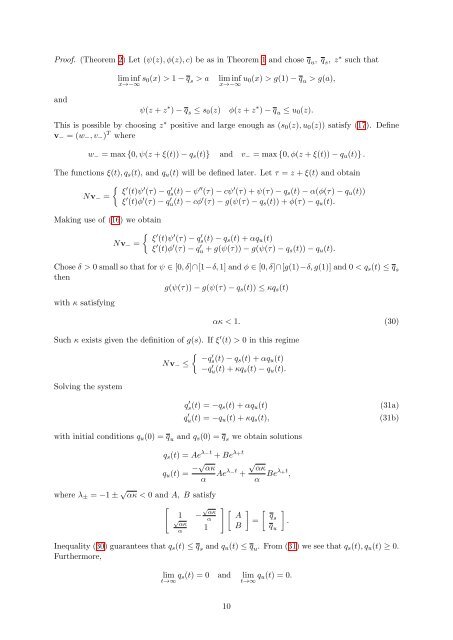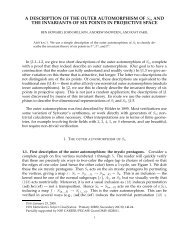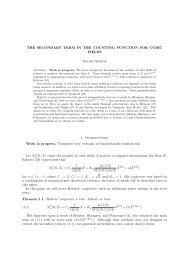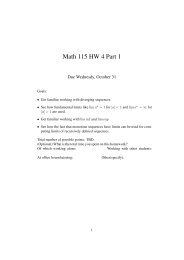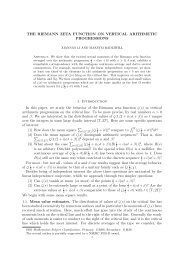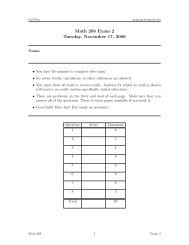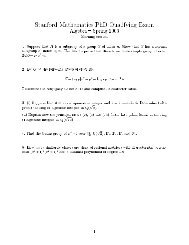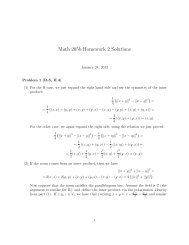Traveling Wave Solutions in a Reaction-Diffusion Model for Criminal ...
Traveling Wave Solutions in a Reaction-Diffusion Model for Criminal ...
Traveling Wave Solutions in a Reaction-Diffusion Model for Criminal ...
You also want an ePaper? Increase the reach of your titles
YUMPU automatically turns print PDFs into web optimized ePapers that Google loves.
Proof. (Theorem 2) Let (ψ(z), φ(z), c) be as <strong>in</strong> Theorem 1 and chose q u, q s, z ∗ such that<br />
and<br />
lim <strong>in</strong>f<br />
x→−∞ s0(x) > 1 − qs > a lim <strong>in</strong>f<br />
x→−∞ u0(x) > g(1) − qu > g(a),<br />
ψ(z + z ∗ ) − q s ≤ s0(z) φ(z + z ∗ ) − q u ≤ u0(z).<br />
This is possible by choos<strong>in</strong>g z ∗ positive and large enough as (s0(z), u0(z)) satisfy (17). Def<strong>in</strong>e<br />
v− = (w−, v−) T where<br />
w− = max {0, ψ(z + ξ(t)) − qs(t)} and v− = max {0, φ(z + ξ(t)) − qu(t)} .<br />
The functions ξ(t), qs(t), and qu(t) will be def<strong>in</strong>ed later. Let τ = z + ξ(t) and obta<strong>in</strong><br />
<br />
ξ ′ (t)ψ ′ (τ) − q ′<br />
Nv− =<br />
s(t) − ψ ′′ (τ) − cψ ′ (τ) + ψ(τ) − qs(t) − α(φ(τ) − qu(t))<br />
ξ ′ (t)φ ′ (τ) − q ′ u(t) − cφ ′ (τ) − g(ψ(τ) − qs(t)) + φ(τ) − qu(t).<br />
Mak<strong>in</strong>g use of (16) we obta<strong>in</strong><br />
<br />
ξ ′ (t)ψ ′ (τ) − q ′<br />
Nv− =<br />
s(t) − qs(t) + αqu(t)<br />
ξ ′ (t)φ ′ (τ) − q ′ u + g(ψ(τ)) − g(ψ(τ) − qs(t)) − qu(t).<br />
Chose δ > 0 small so that <strong>for</strong> ψ ∈ [0, δ]∩[1−δ, 1] and φ ∈ [0, δ]∩[g(1)−δ, g(1)] and 0 < qs(t) ≤ q s<br />
then<br />
g(ψ(τ)) − g(ψ(τ) − qs(t)) ≤ κqs(t)<br />
with κ satisfy<strong>in</strong>g<br />
Such κ exists given the def<strong>in</strong>ition of g(s). If ξ ′ (t) > 0 <strong>in</strong> this regime<br />
<br />
−q ′<br />
Nv− ≤ s(t) − qs(t) + αqu(t)<br />
−q ′ u(t) + κqs(t) − qu(t).<br />
Solv<strong>in</strong>g the system<br />
ακ < 1. (30)<br />
q ′ s(t) = −qs(t) + αqu(t) (31a)<br />
q ′ u(t) = −qu(t) + κqs(t), (31b)<br />
with <strong>in</strong>itial conditions qu(0) = q u and qs(0) = q s we obta<strong>in</strong> solutions<br />
qs(t) = Ae λ−t + Be λ+t<br />
qu(t) = −√ ακ<br />
α Aeλ−t +<br />
where λ± = −1 ± √ ακ < 0 and A, B satisfy<br />
<br />
√<br />
ακ<br />
1 −<br />
√ α<br />
ακ<br />
α<br />
1<br />
A<br />
B<br />
√ ακ<br />
α Beλ+t ,<br />
Inequality (30) guarantees that qs(t) ≤ q s and qu(t) ≤ q u. From (31) we see that qs(t), qu(t) ≥ 0.<br />
Furthermore,<br />
<br />
=<br />
qs<br />
q u<br />
<br />
.<br />
lim<br />
t→∞ qs(t) = 0 and lim qu(t) = 0.<br />
t→∞<br />
10


